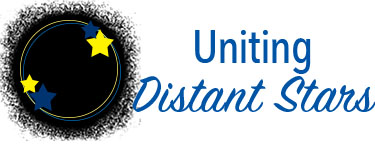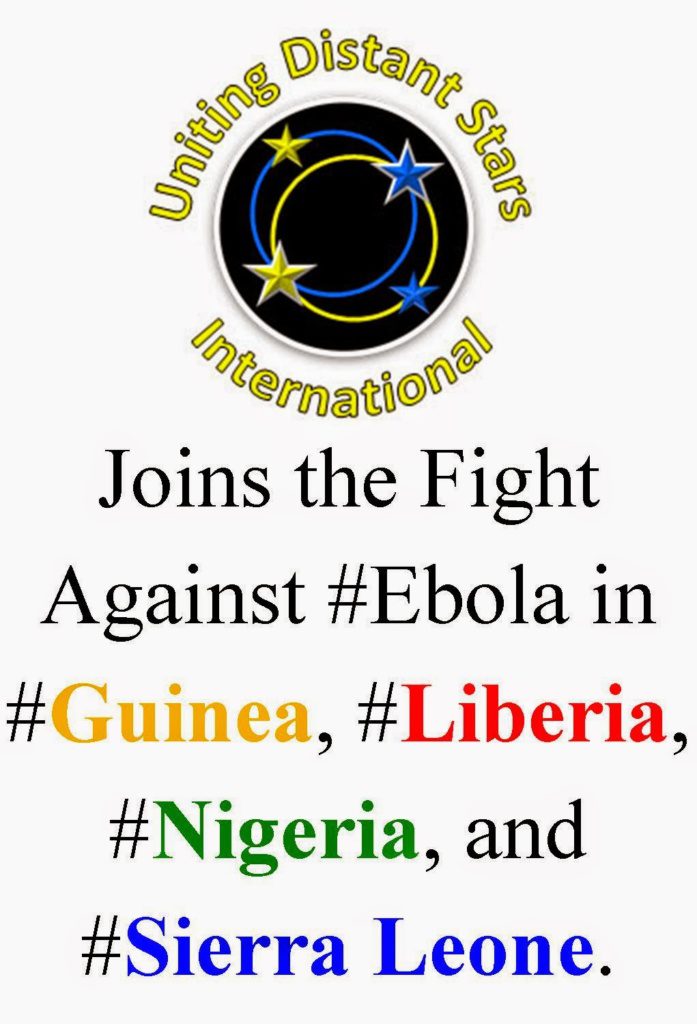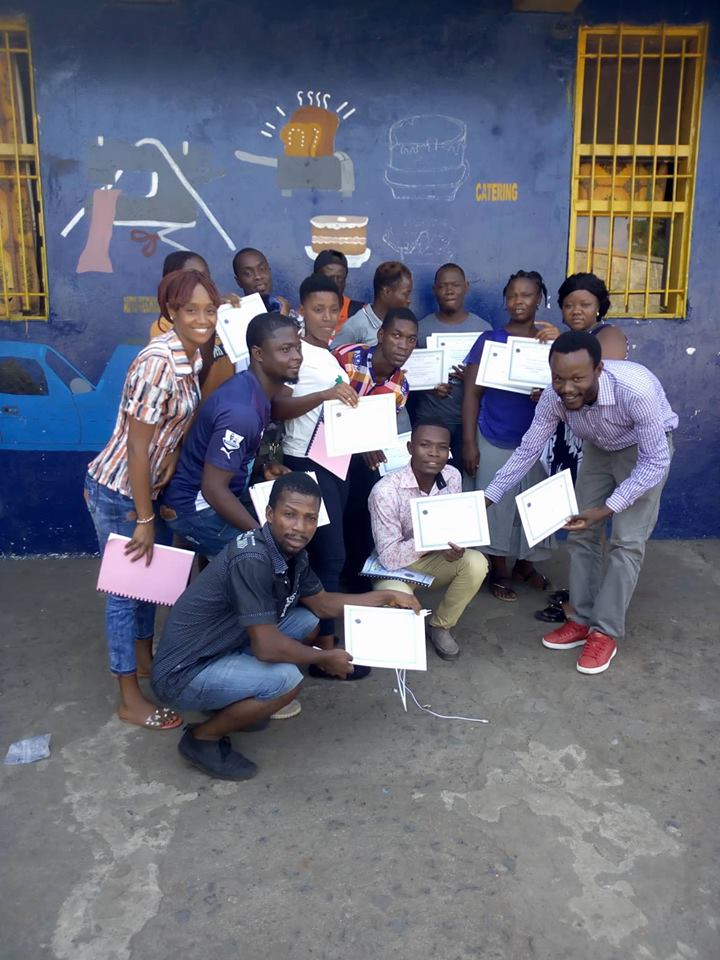
by heather-cstars | Jan 20, 2019 | Africa, African Dream Academy, Cake, Catering Course, Hotel Management Course, Liberia, NGO, Permaculture Training, Sierra Leone, Sierra Leone Foundation for New Democracy, Skills training, Trade School, Uniting Distant Stars, vocational training, youth development, Youth Leadership
Our first permaculture training successfully ended on January 16, 2019. Last week, we shared photos and information about the first five days of training. This week’s article focuses on the remaining four days of the Permaculture Design Certification Training.
Day 6 – Polyculture & Introduction to Group Projects
Bruce Blair (Board Member & Trainer for SLFND) demonstrated the benefits of polyculture with a model. He explained that polyculture is where unrelated plants grow together. He also showed videos of one particular type of polyculture: The Three Sisters. Typically, the Three Sisters include corn (maize), climbing beans, and squash. This practice originated from Native Americans.

Bruce Blair (SLFND) sharing short documentaries on polyculture and explaining the process to our students.
Bruce discussed group assignments where students create their own design projects. Additionally, he gave our students the option to select a site or social design. What is the difference? Site design focuses on a single garden or farm project, whereas social design includes the whole system design (i.e. economic, environment, health, etc.).

Bruce explaining the group design projects using his model as the example.
After the assignment discussion, the students reviewed the notes on the board in preparation for their group project. Group presentations started on Monday.
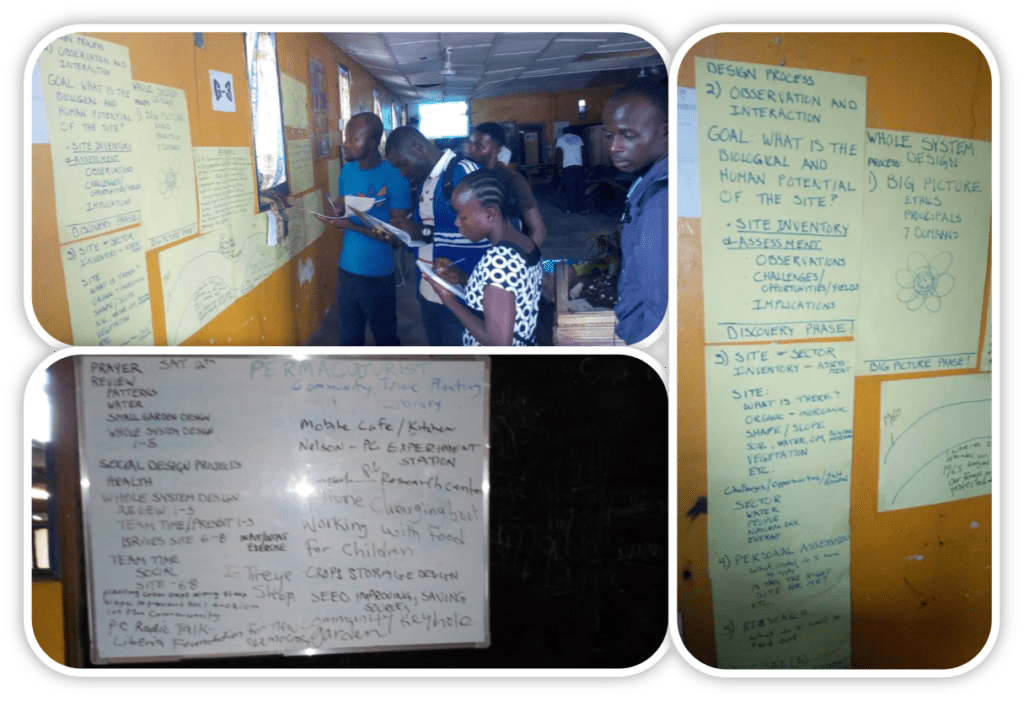
UDS students taking notes of their group project assignment.
Days 7 & 8 – Student Presentations of Group Projects & Banana Cycle
On Monday, the groups took their turn to demonstrate what they learned in this class. Each student of the group needed to share something about their project in order for Bruce to assess their knowledge of the permaculture process. As you see in the photos below, our students used different types of 2-D or 3-D models to explain their group projects.
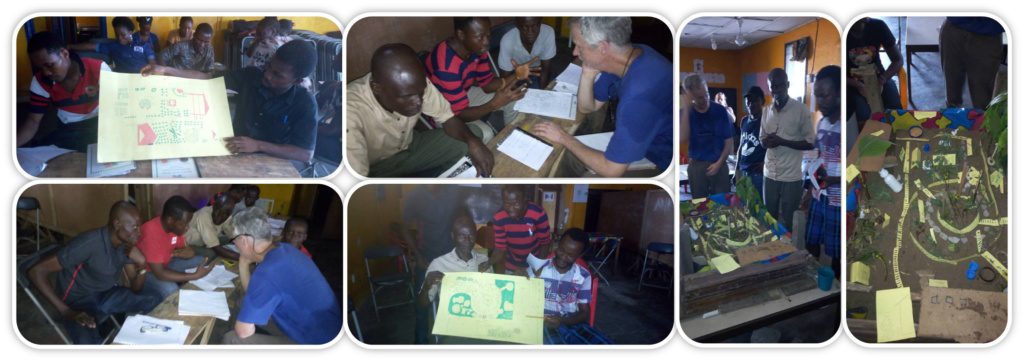
Photos (left to right) show different group presenting their group projects. Some drew their designs on paper while others used a 3-d model.
On Tuesday, Bruce took the group over to the field site to discuss the banana cycle. A banana tree can reproduce itself. Instead of a seed, it grows from the bulb (rhizome).

Bruce explaining how the banana tree reproduces itself.
Day 9 – Final Presentations & Certification Ceremony
The group presentations continued into day 9. Clearly, our students put a great deal of effort into their group project designs. As result, they met the course requirements to be certified in Permaculture Design.

UDS Co-Founder & Director was part of this group project on social design.
Halfway through the day, they paused the group presentations. Joy Alizadeh would soon be leaving, and they wanted to recognize both her and Bruce. So, Kelvin Fomba (UDS Co-Founder & Director) joined Bruce and Joy up front to express the gratitude of all the students. Then he presented them a surprise Thank You Cake made by our catering students.
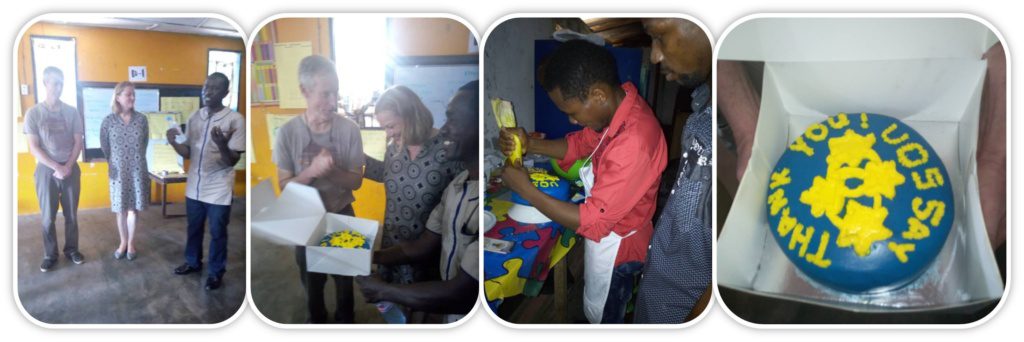
Photos (left to right): 1) Kelvin giving UDS appreciation to Bruce & Joy, 2) Kelvin presenting the Thank You cake to Bruce & Joy, 3) Catering Students icing the cake, & 4) Bruce holding the cake.
Soon after Joy left, the group presentations resumed. Once the last one ended, the certification ceremony began. Our long-time friend, Rev. Samuel Enders presented each student with their certificate. He also gave a motivational speech about taking this knowledge and putting it to use immediately. In fact, this course taught our students they can start with the resources of the earth and their own two hands.
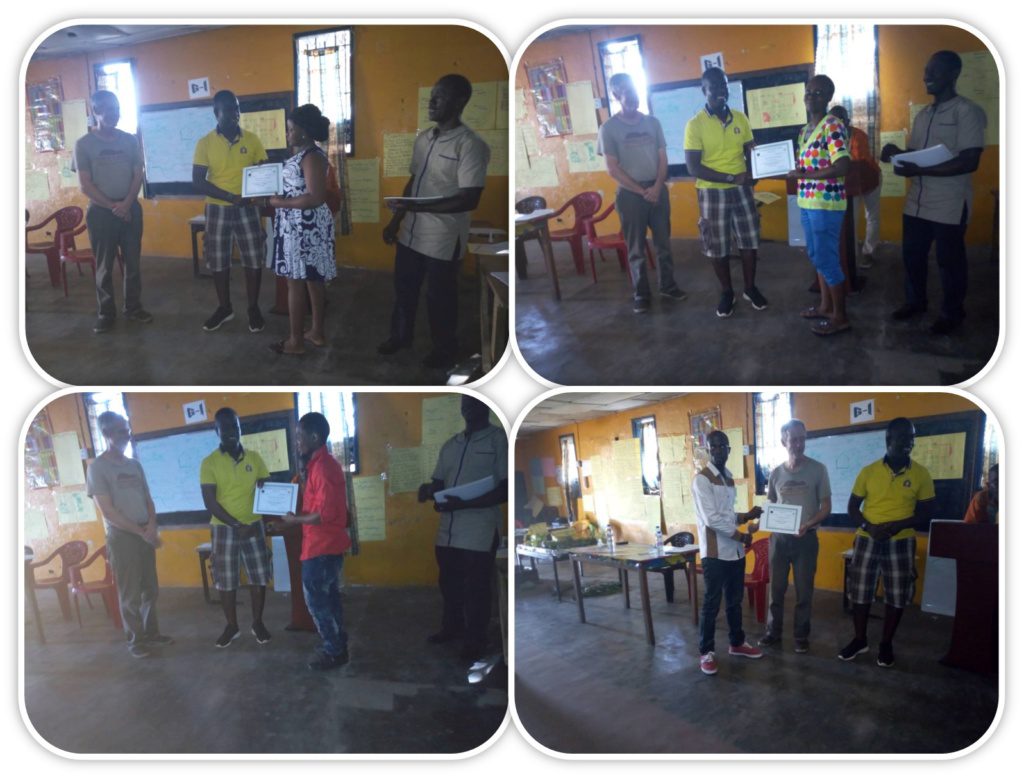
Rev. Samual Enders of African Dream Academy (yellow polo) presented the students with their certificates. Bruce is on the left and Kelvin on the right.
Celebration!
Next, our students took photos to share their excitement with you. We had 41 out of 45 students successfully complete this course. Unfortunately, the other four had to drop due to scheduling conflicts.
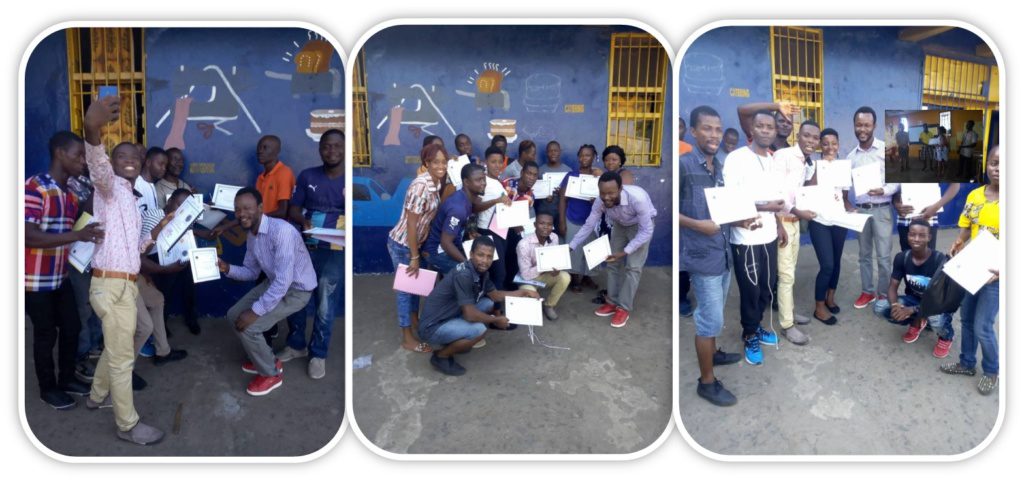
UDS students celebrating and proudly displaying their certificates.
Finally, I want to Thank all our dedicated students and team for their active participation in this course and taking good care of our guests! Additionally, I want to extend our sincerest Thanks to our four sponsors (Ali, John, Edward, and Joel) and SLFND Team (Hindolo, Bruce, Joy, and Brenda) for their support!
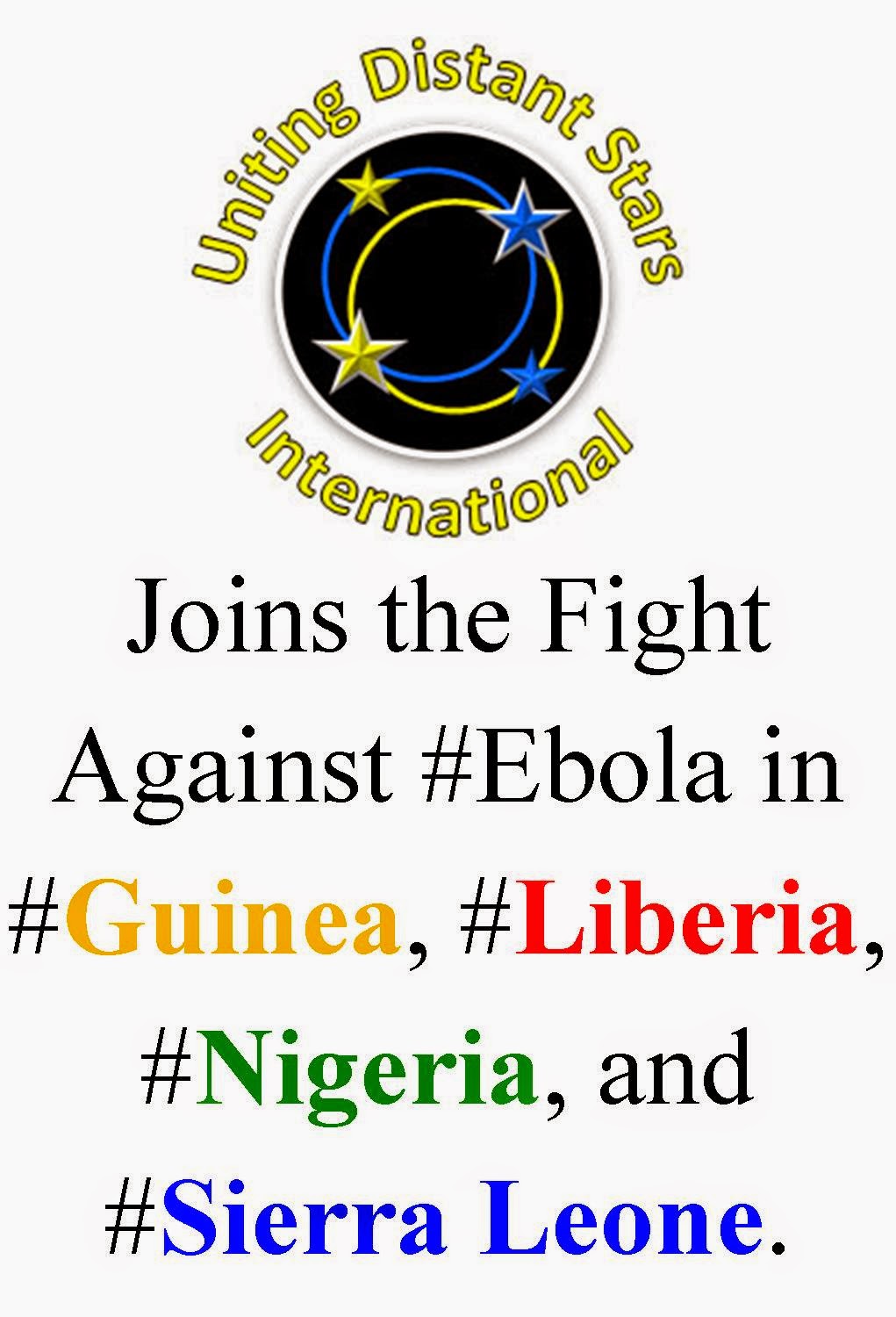
by heather-cstars | Aug 9, 2014 | Uncategorized
In the last two weeks, the
Ebola Virus (aka Ebola hemorrhagic fever) has dominated the world news media with varying reports. These have either alarmed and terrified the international community or educated and mobilized diverse groups of passionate global citizens like
Uniting Distant Stars to join the fight against this deadly, but preventable disease.
Since the Ebola outbreak, I have been following the news reports from several sources while researching what this disease is, how it is transmitted, and how it can be prevented. If one solely relies on the news media, they might as well start singing REM’s popular song “It is the end of the world as we know it.” However, if you supplement the news with thoughtful research of comparisons of earlier outbreaks with the one currently in West Africa, you will find a glimmer of hope.
For example, in Greg Laden’s July 27, 2014, ScienceBlogs post “Ebola Outbreak in West Africa: Some basic information (Updated),” he reviews the statistics of all cases since 1976. Within his research, he debunks the widely believed 90% mortality rate that has been frequently cited in media organizations from CNN to Wikipedia. He states, “Ebola probably has a very high mortality rate when an infected person
gets no medical treatment, and a mortality rate closer to 50% when a
person quickly gets medical attention.” It appears that with early detection of this disease, the survival chances of its victims are greater.
Then there is the likes of the Belgian Professor Peter Piot, one of the discoverers of this rare disease during its first known outbreak during 1970’s in the former Zaire (now Democratic Republic of Congo). He recently said in a Telegraph interview that he would ride next to someone with Ebola on the train. He stressed how this situation is unlikely to cause a major epidemic outside of the affected areas. In this same interview, he explained why the current outbreak was not contained was due to “a ‘really bad’ sense of panic and
lack of trust in the authorities in West Africa had contributed to the
world’s largest-ever outbreak.”
Leading up to the recent fervor about this devastating humanitarian crisis, there been a lot of denial, disbelief, misinformation and lack of coordination between
the three West African governments and international aid agencies with various medical
organizations like Doctors Without Borders treating the infected patients, who have been pleading for additional help and supplies.
Many media outlets have played their part in misleading the international community of this rare and hard to get disease. This has spread the sense of fear and panic to many parts of the world, including the U.S. on whether someone coming from West Africa could be carrying this disease. This concern was intensified recently when an unknown man returning from West Africa was isolated at Mount Sinai Hospital in New York, when he arrived in its emergency room with a high fever and gastrointestinal symptoms. His tests soon revealed that he was negative of Ebola, but this did not alleviate the dismay of the people.
What Ebola has taught the world is that information is POWER. It can spread FEAR if the headlines are littered with stories of gloom or doom. Or it can spark HOPE if stories are shared that educate people on the facts and what can be done to prevent and stop the problem.
Since Uniting Distant Stars is working in Liberia, where Ebola has wreaked havoc on the people, we will continue to do our part in promoting HOPE through education and awareness.





